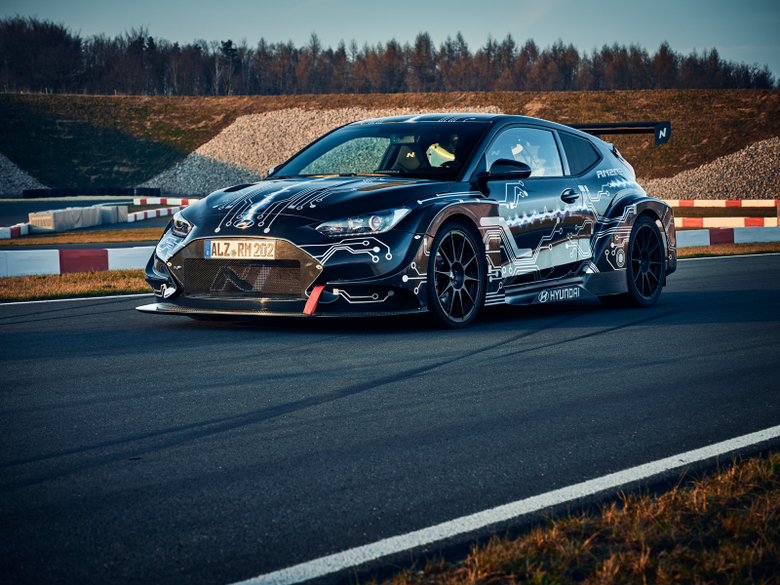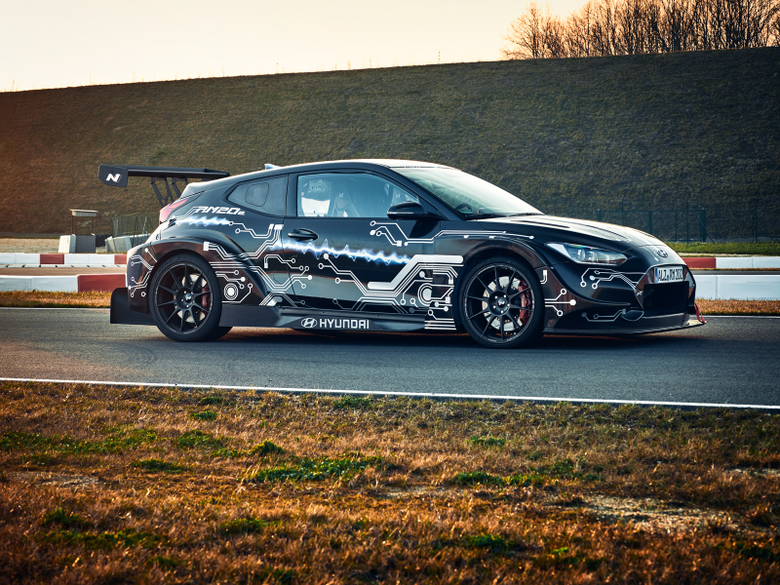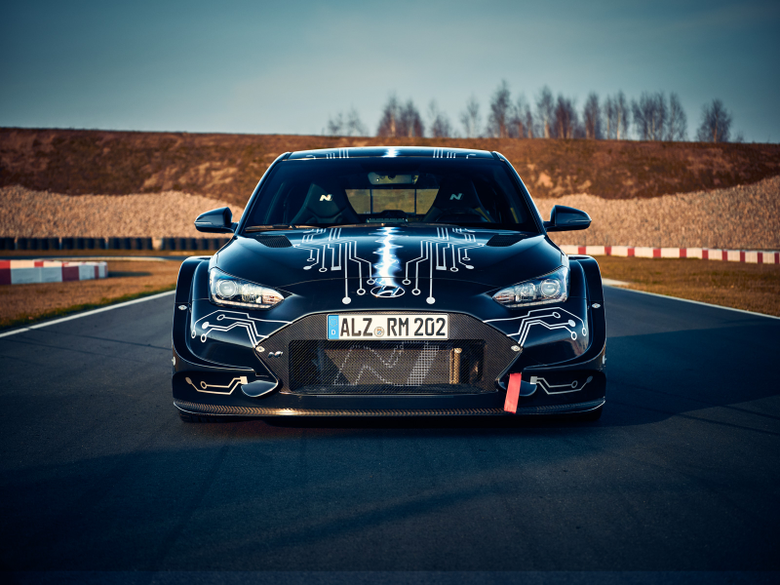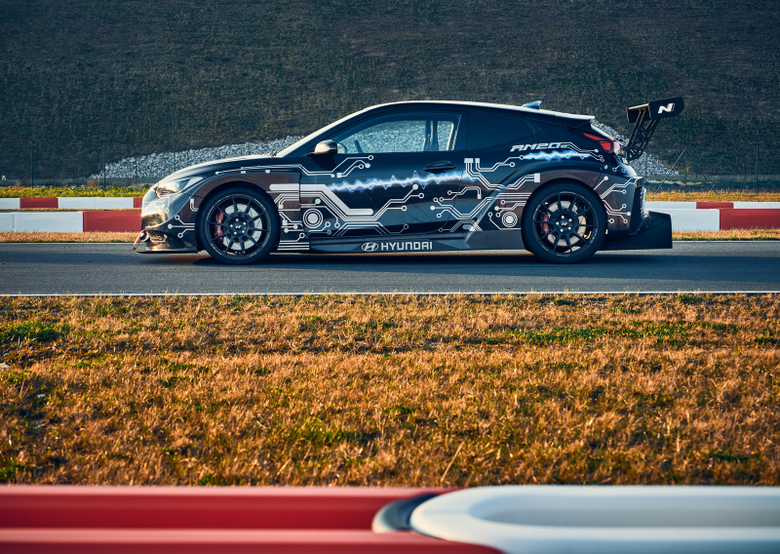The Hyundai RM20e Exists To Figure Out What Fun Means For Electric Cars
The Hyundai RM20e is an 810-horsepower super hatchback, but it's also an evolving testbed for the South Korean automaker's performance technology. Like its predecessors, this prototype is getting whipped around racetracks so that its tech can (we hope) trickle down to roads.
While Hyundai has clearly been hard at work improving the overall quality of its cars in recent years, it seems it's also been messing with fast-going technology. I have to admit, even after becoming a big fan of Hyundai's Veloster N hot hatch, I totally forgot that the company has been making midengine high-performance prototypes since 2012.
These cars are not exactly precursors to production models, but the idea is that they test performance at extremes so that more practical variants can be built on assembly lines. Which, I guess, makes sense. What do I know, I'm just a blogger.
The RM20e here is the latest in that line of dream machines and the first to be electric. Hyundai released this sizzle reel recently along with some claimed specs: 810 HP, 708 lb-ft of torque and a time for 0-to-200 kph (about 124 mph) at 9.88 seconds. That's kind of a weird measure of acceleration, but based on the video clip I'd imagine it feels pretty fast.
As the accompanying ad copy states:
"Project RM, which stands for 'Racing Midship' was launched in 2012 to develop and connect new high-performance motorsports technologies with future N models. Ever since, the 'rolling lab' has been in charge of progressive evolution in N cars. Likewise, this time we are about to witness the next generation of N performance, electrification."
Hyundai actually has a whole site dedicated to this thing, which is mostly just hype content, but it's fun to look at. And more important, it seems like a reasonably strong indicator that the car company is serious about pairing electric power with serious performance.
The RM20e's press release adds that the vehicle was developed in part thanks to Hyundai's "recent investment and strategic partnership with Rimac Automobili." Apparently Hyundai plans to churn out 44 models it considers eco-friendly by 2025 and seems to be planning on moving its performance portfolio to electricity. At least, that's how I'm interpreting the line: "...taking the Hyundai N brand into the forefront of environmental responsibility."
I just hope Hyundai spends time and energy figuring out how to inject real soul and feeling into whatever future EV performance car it ends up turning out. We know EVs can zoom off a stop like shit off a chrome shovel, but that party trick doesn't have so much practical value. What really makes a car fun to drive is a sense of connectivity between driver and machine. Hyundai's proved it understands that by producing the Veloster N, so I'm optimistic about the company porting the concept to an electric-propulsion future.
Hyundai also published a more complete list of the prototype car's specs, which I'll port here to peruse if you're interested:
RM20e (Hyundai N brand prototype) Specifications
Concept
Midship, rear-drive high-performance sports prototype
electrified powertrain
Body Configuration
Two-seat, two-door coupe (Veloster N body-in-white)
Aluminum extrusion front subframe
Steel tube-and-plate rear subframe
Powertrain Layout
Midship motor, rear-drive electric axle
Aerodynamics
Front splitter, large wing spoiler and rear air diffuser
Motor
800-volt motor and inverter technology
596 kW peak power (20-second interval)
960 Nm peak torque
(810 Horsepower and 708 lb-ft torque equivalent)
Gearbox
Single reduction ratio 1:5.67
Straight-cut gears (spur)
Battery
Energy: 60 kWh; peak power: 600 kW
Nominal voltage: 605 V; peak voltage: 705 V
Liquid-flooded battery-module technology
800-volt fast-charging capability
Top Speed
250 KPH (> 155 MPH)
* speed limited for public road driving
Suspension Type
(Front) MacPherson / (Rear) Double-Wishbone
Adjustable hard points and geometry
Dampers
Conventional gas-pressure dampers
Brake
6-piston (front) / 4-piston (rear)
Parking Brake
Mechanical type, in rear
ABS System
Motorsport ABS M5 (Bosch)
* Not valid for public roads
Steering Assist
Rack-mounted motor-driven power steering
Steering Wheel Design
Veloster N TCR design (with paddle shifters)
Overall Dimensions (mm)
4319 (length) x 1945 (width) x 1354 (height) /
2672 (wheelbase)
Interior
Sabelt® sport seats, 6-point safety harness system
E-drive dedicated instrument cluster
Overhang (mm)
899 (front) / 748 (rear)
Minimum Ground Clearance
80 mm
Tires
(Front) 265/35R19, (Rear) 305/30R20
Wheels
19" X 10" (front) / 20" X 11" (rear)
One-piece lightweight forged aluminum alloy wheels
Larger, flared wheel-housing design





